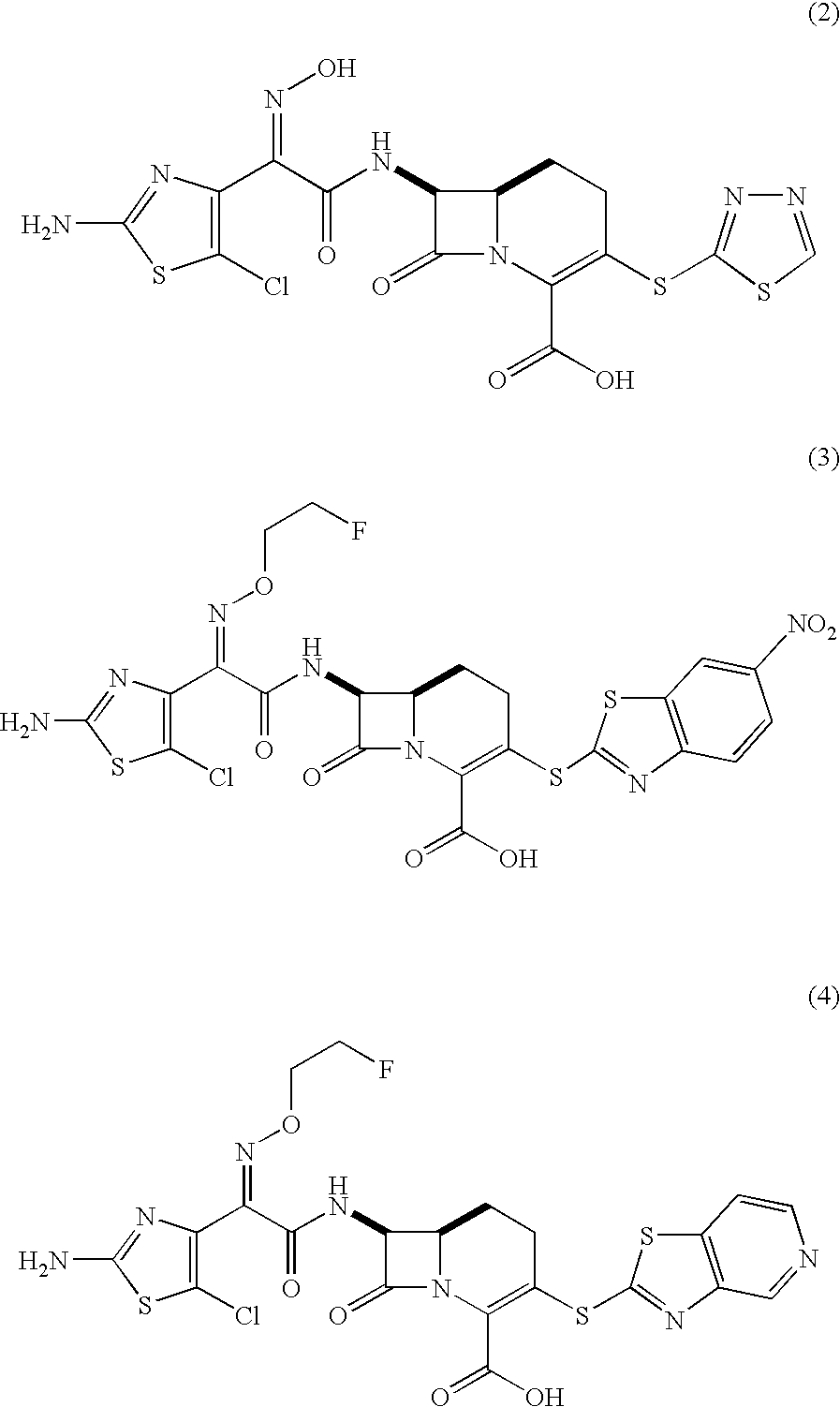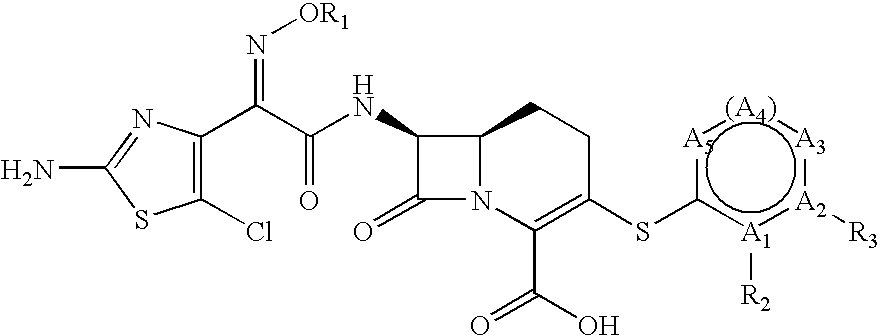Carbacephem beta-lactam antibiotics
- Summary
- Abstract
- Description
- Claims
- Application Information
AI Technical Summary
Benefits of technology
Problems solved by technology
Method used
Image
Examples
example 1
(7R)-7-[(Z)-2-(2-amino-5-chlorothiazol-4-yl)-2-(triphenylmethoxyimino]-acetamido]-3-chloro-8-oxo-1-aza-bicyclo[4.2.0]oct-2-ene-2-carboxylate triethyl amine salt
To a solution of bis-(2-benzothiazolyl)-disulfide (4.3 g, 0.013 mol) in dichloromethane (100 mL) was added triphenylphosphine (3.4 g, 0.013 mol). The mixture was stirred for 15 minutes after which (Z)-2-(2-amino-5-chlorothiazol-4-yl)-2-(triphenylmethoxyimino)acetic acid (4.9 g, 0.010 mol) was added. The mixture was stirred for 1 hour and was cooled to 0° C. In a separate flask, (7R)-7-amino-3-chloro-8-oxo-1-aza-bicyclo[4.2.0]oct-2-ene-2-carboxylic acid trifluoroacetic acid salt (2.6 g, 0.008 mol) was suspended in dichloromethane (50 mL) and triethylamine (4.0 g, 0.04 mol) was added. The suspension was stirred for 0.5 hour at room temperature and then was transferred to the flask containing the activated ester of 7-[(Z)-2-(2-amino-5-chlorothiazolyl-4)-2-trityloxyimino] carboxylic acid. The resulting clear solution was allow...
example 2
(7R)-7-[(Z)-2-(2-amino-5-chlorothiazol-4-yl)-2-(triphenylmethoxyimino]-acetamido]-3-chloro-8-oxo-1-aza-bicyclo[4.2.0]oct-2-ene-2-carboxylate diphenylmethyl ester
The crude (7R)-7-[(Z)-2-(2-amino-5-chlorothiazol-4-yl)-2-triphenylmethoxyimino]-acetamido]-3-chloro-8-oxo-1-aza-bicyclo[4.2.0]oct-2-ene-2-carboxylic acid triethylamine salt (6.5 g.) was dissolved in dichloromethane (200 mL) and was washed twice with 50% H3PO4 / H2O and then with water. The organic layer was dried over anhydrous MgSO4, filtered and treated with diphenyldiazomethane solution in dichloromethane (40 mL of 0.5 mol / L solution, 0.02 mol), followed by stirring at room temperature for 1 hour. The reaction mixture was concentrated to dryness and the residue was dissolved in ethyl acetate (20 mL). The ethyl acetate solution was then chromatographed on silica gel (200 g). Nonpolar byproducts were eluted with ethyl acetate:hexane (1:6), and the product with ethyl:acetate:hexane (1:1). After evaporation, the title ester ...
example 3
(7R)-7-[(Z)-2-(2-amino-5-chlorothiazol-4-yl)-2-(triphenylmethoxyimino]-acetamido]-3-[5-amino-1,3,4-thiadiazol-2-ylthio]-8-oxo-1-aza-bicyclo[4.2.0]oct-2-ene-2-carboxylate diphenylmethyl ester
To a solution of 5-amino-1,3,4-thiadiazole-2-thiol (0.6 g., 0.0045 mol) in dimethylformamide (25 mL) was added potassium carbonate (1.0 g, 0.0076 mol). The mixture was stirred for 1 hour at room temperature after which (7R)-7-[(Z)-2-(2-amino-5-chlorothiazol-4-yl)-2-(triphenylmethoxyimino]acetamido]-3-chloro-8-oxo-1-aza-bicyclo[4.2.0]oct-2-ene-2-carboxylate diphenylmethyl ester (3.2 g., 0.0039 mol) was added. Stirring was continued for 18 hours. The mixture was partitioned between ethyl acetate (50 mL) and water (50 mL). The organic layer was separated, washed with water (30 mL), dried over anhydrous MgSO4 and the solvent was removed with a rotary evaporator. The resultant thick oil was treated with diethyl ether (50 mL) and the solid which formed was filtered and dried to give 2.6 g of crude p...
PUM
| Property | Measurement | Unit |
|---|---|---|
| Current | aaaaa | aaaaa |
| Electrical resistance | aaaaa | aaaaa |
| Chemical structure | aaaaa | aaaaa |
Abstract
Description
Claims
Application Information
 Login to View More
Login to View More - R&D
- Intellectual Property
- Life Sciences
- Materials
- Tech Scout
- Unparalleled Data Quality
- Higher Quality Content
- 60% Fewer Hallucinations
Browse by: Latest US Patents, China's latest patents, Technical Efficacy Thesaurus, Application Domain, Technology Topic, Popular Technical Reports.
© 2025 PatSnap. All rights reserved.Legal|Privacy policy|Modern Slavery Act Transparency Statement|Sitemap|About US| Contact US: help@patsnap.com



